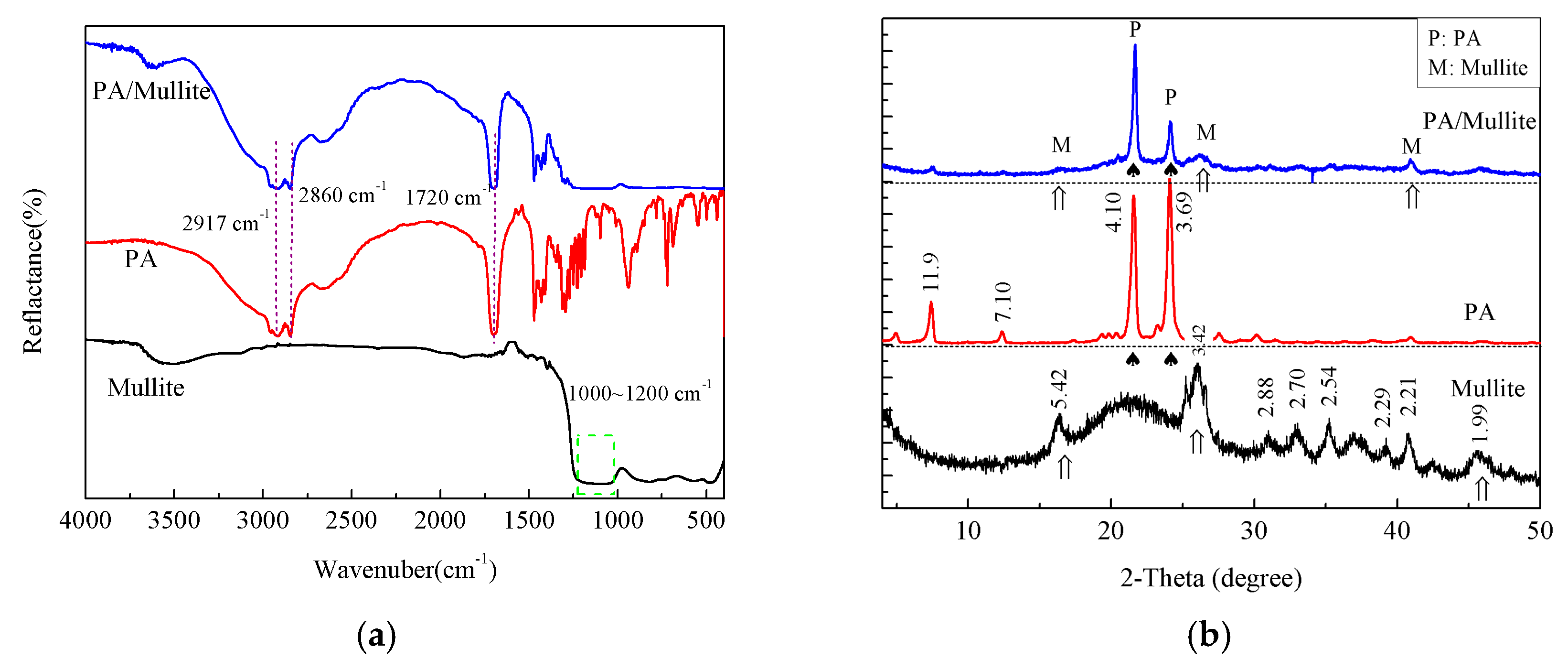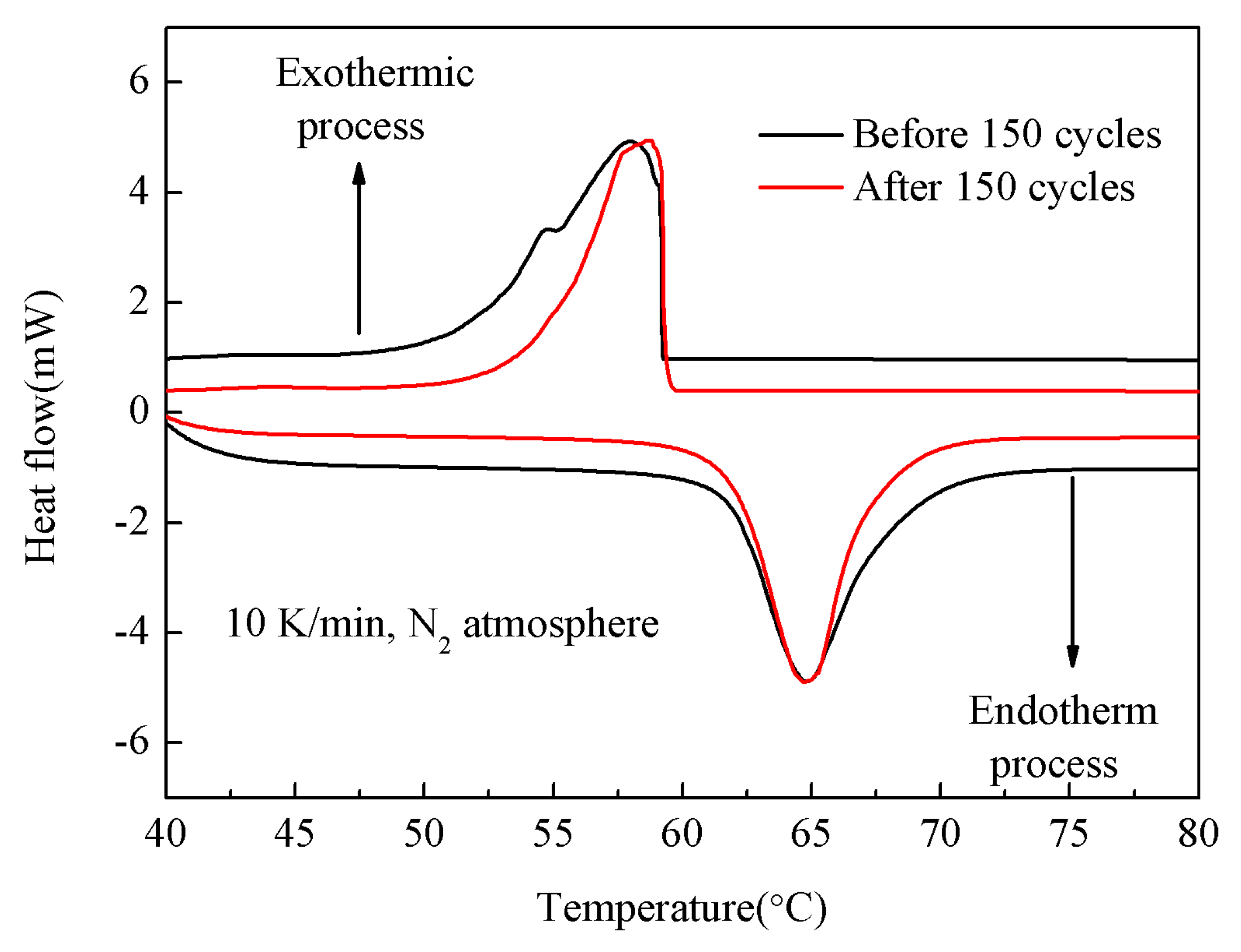Mullite Stabilized Palmitic Acid as Phase Change Materials for Thermal Energy Storage
Abstract
:1. Introduction
2. Experimental Section
2.1. Materials
2.2. Preparation of PA/Mullite FSPCM
2.3. Characterization Techniques
3. Results and Discussion
3.1. Chemical Compatibility of the PA/Mullite FSPCM
3.2. The Microstructure of the PA/Mullite FSPCM
3.3. Thermal Properties of the PA/Mullite FSPCM
3.4. Thermal Stability of PA and PA/Mullite FSPCM
3.5. The Cooling Curve of the PA/Mullite FSPCM
4. Conclusions
Author Contributions
Funding
Conflicts of Interest
References
- Abokersh, M.; Osman, M.; El-Baz, O.; El-Morsi, M.; Sharaf, O. Review of the phase change material (PCM) usage for solar domestic water heating systems (SDWHS). Int. J. Energy Res. 2018, 42, 329–357. [Google Scholar] [CrossRef]
- Lv, P.; Liu, C.; Rao, Z. Review on clay mineral-based form-stable phase change materials: Preparation, characterization and applications. Renew. Sustain. Energy Rev. 2017, 68, 707–726. [Google Scholar] [CrossRef]
- Gu, X.; Qin, S.; Wu, X.; Li, Y.; Liu, Y. Preparation and thermal characterization of sodium acetate trihydrate/expanded graphite composite phase change material. J. Therm. Anal. Calorim. 2016, 125, 831–838. [Google Scholar] [CrossRef]
- Sharma, A.; Tyagi, V.; Chen, C.; Buddhi, D. Review on thermal energy storage with phase change materials and applications. Renew. Sustain. Energy Rev. 2009, 13, 318–345. [Google Scholar] [CrossRef]
- Zalba, B.; Marin, J.; Cabeza, L.; Mehling, H. Review on thermal energy storage with phase change: Materials, heat transfer analysis and applications. Appl. Therm. Eng. 2003, 23, 251–283. [Google Scholar] [CrossRef]
- Ibrahim, N.; Al-Sulaiman, F.; Rahman, S.; Yilbas, B.; Sahin, A. Heat transfer enhancement of phase change materials for thermal energy storage applications: A critical review. Renew. Sustain. Energy Rev. 2017, 74, 26–50. [Google Scholar] [CrossRef]
- Sarı, A. Fabrication and thermal characterization of kaolin-based composite phase change materials for latent heat storage in buildings. Energy Build. 2015, 96, 193–200. [Google Scholar] [CrossRef]
- Liu, S.; Yang, H. Stearic acid hybridizing coal–series kaolin composite phase change material for thermal energy storage. Appl. Clay Sci. 2014, 101, 277–281. [Google Scholar] [CrossRef]
- Karaipekli, A.; Biçer, A.; Sarı, A.; Tyagi, V. Thermal characteristics of expanded perlite/paraffin composite phase change material with enhanced thermal conductivity using carbon nanotubes. Energy Convers. Manag. 2017, 134, 373–381. [Google Scholar] [CrossRef]
- Lv, P.; Liu, C.; Rao, Z. Experiment study on the thermal properties of paraffin/kaolin thermal energy storage form-stable phase change materials. Appl. Energy 2016, 182, 475–487. [Google Scholar] [CrossRef]
- Fu, X.; Liu, Z.; Xiao, Y.; Wang, J.; Lei, J. Preparation and properties of lauric acid/diatomite composites as novel form-stable phase change materials for thermal energy storage. Energy Build. 2015, 104, 244–249. [Google Scholar] [CrossRef]
- Peng, K.; Fu, L.; Li, X.; Ouyang, J.; Yang, H. Stearic acid modified montmorillonite as emerging microcapsules for thermal energy storage. Appl. Clay Sci. 2017, 138, 100–106. [Google Scholar] [CrossRef]
- Li, C.; Fu, L.; Ouyang, J.; Tang, A.; Yang, H. Kaolinite stabilized paraffin composite phase change materials for thermal energy storage. Appl. Clay Sci. 2015, 115, 212–220. [Google Scholar] [CrossRef]
- Xu, B.; Li, Z. Performance of novel thermal energy storage engineered cementitious composites incorporating a paraffin/diatomite composite phase change material. Appl. Energy 2014, 121, 114–122. [Google Scholar] [CrossRef]
- Li, M.; Wu, Z.; Kao, H. Study on preparation, structure and thermal energy storage property of capric–palmitic acid/attapulgite composite phase change materials. Appl. Energy 2011, 88, 3125–3132. [Google Scholar] [CrossRef]
- Ramakrishnan, S.; Wang, X.; Sanjayan, J.; Wilson, J. Assessing the feasibility of integrating form-stable phase change material composites with cementitious composites and prevention of PCM leakage. Mater. Lett. 2017, 192, 88–91. [Google Scholar] [CrossRef]
- Ramakrishnan, S.; Wang, X.; Sanjayan, J.; Wilson, J. Thermal energy storage enhancement of lightweight cement mortars with the application of phase change materials. Procedia Eng. 2017, 180, 1170–1177. [Google Scholar] [CrossRef]
- Xu, B.; Ma, H.; Lu, Z.; Li, Z. Paraffin/expanded vermiculite composite phase change material as aggregate for developing lightweight thermal energy storage cement-based composites. Appl. Energy 2015, 160, 358–367. [Google Scholar] [CrossRef]
- Song, S.; Dong, L.; Zhang, Y.; Chen, S.; Li, Q.; Guo, Y.; Xiong, C. Lauric acid/intercalated kaolinite as form-stable phase change material for thermal energy storage. Energy 2014, 76, 385–389. [Google Scholar] [CrossRef]
- Cai, Y.; Song, L.; He, Q.; Yang, D.; Hu, Y. Preparation, thermal and flammability properties of a novel form-stable phase change materials based on high density polyethylene/poly (ethylene-co-vinyl acetate)/organophilic montmorillonite nanocomposites/paraffin compounds. Energy Convers. Manag. 2008, 49, 2055–2062. [Google Scholar] [CrossRef]
- Yu, Z.; Wang, Y.; Liu, X.; Sun, J.; Sha, G.; Yang, J.; Meng, C. A novel pathway for the synthesis of ordered mesoporous silica from diatomite. Mater. Lett. 2014, 119, 150–153. [Google Scholar] [CrossRef]
- Karaipekli, A.; Sarı, A. Preparation, thermal properties and thermal reliability of eutectic mixtures of fatty acids/expanded vermiculite as novel form-stable composites for energy storage. J. Ind. Eng. Chem. 2010, 16, 767–773. [Google Scholar] [CrossRef]
- Song, S.; Dong, L.; Chen, S.; Xie, H.; Xiong, C. Stearic–capric acid eutectic/activated-attapulgiate composite as form-stable phase change material for thermal energy storage. Energy Convers. Manag. 2014, 81, 306–311. [Google Scholar] [CrossRef]
- Liu, R.; Zhang, F.; Su, W.; Zhao, H.; Wang, C. Impregnation of porous mullite with Na2SO4 phase change material for thermal energy storage. Sol. Energy Mater. Sol. Cells. 2015, 134, 268–274. [Google Scholar] [CrossRef]
- Liu, S.; Yang, H. Porous ceramic stabilized phase change materials for thermal energy storage. RSC Adv. 2016, 6, 4833–4842. [Google Scholar] [CrossRef]
- Xu, X.; Zhang, Y.; Wu, J.; Hu, C.; Tang, Z. Preparation and performance study of cordierite/mullite composite ceramics for solar thermal energy storage. Int. J. Appl. Ceram. Technol. 2017, 14, 162–172. [Google Scholar] [CrossRef]
- Sarı, A.; Bicer, A.; Al-Ahmed, A.; Al-Sulaiman, F.; Zahir, M.; Mohamed, S. Silica fume/capric acid-palmitic acid composite phase change material doped with CNTs for thermal energy storage. Sol. Energy Mater. Sol. Cells 2018, 179, 353–361. [Google Scholar] [CrossRef]
- Zeng, J.; Sun, S.; Zhou, L.; Chen, Y.; Shu, L.; Yu, L.; Zhu, L.; Song, L.; Cao, Z.; Sun, L. Preparation, morphology and thermal properties of microencapsulated palmitic acid phase change material with polyaniline shells. J. Therm. Anal. Calorim. 2017, 129, 1583–1592. [Google Scholar] [CrossRef]
- Zhang, Z.; Zhang, N.; Peng, J.; Fang, X.; Gao, X.; Fang, Y. Preparation and thermal energy storage properties of paraffin/expanded graphite composite phase change material. Appl. Energy 2012, 91, 426–431. [Google Scholar] [CrossRef]
- Li, M.; Guo, Q.; Nutt, S. Carbon nanotube/paraffin/montmorillonite composite phase change material for thermal energy storage. Sol. Energy 2017, 146, 1–7. [Google Scholar] [CrossRef] [PubMed] [Green Version]
- Zhang, P.; Meng, Z.; Zhu, H.; Wang, Y.; Peng, S. Melting heat transfer characteristics of a composite phase change material fabricated by paraffin and metal foam. Appl. Energy 2017, 185, 1971–1983. [Google Scholar] [CrossRef]
- Khorchani, I.; Hafef, O.; Reinosa, J.; Matoussi, A.; Fernandez, J. AC electrical conduction mechanisms and dielectrical studies of DD3 kaolin sintered at high temperature. Mater. Chem. Phys. 2018, 212, 187–195. [Google Scholar] [CrossRef]
- Liu, S.; Yang, H. Composite of Coal-Series Kaolinite and Capric-Lauric Acid as Form-Stable Phase-Change Material. Energy Technol. 2015, 3, 77–83. [Google Scholar] [CrossRef]
- Ali, M.; Yiu, L.; Shi, X.; Barbhuiya, S.; Cui, H. Preparation, characterization and thermal properties of Lauryl alcohol/Kaolin as novel form-stable composite phase change material for thermal energy storage in buildings. Appl. Therm. Eng. 2013, 59, 336–347. [Google Scholar]
- Min, X.; Fang, M.; Huang, Z.; Huang, Y.; Wen, R.; Qian, T.; Wu, X. Enhanced thermal properties of novel shape-stabilized PEG composite phase change materials with radial mesoporous silica sphere for thermal energy storage. Sci. Rep. 2015, 5, 12964. [Google Scholar] [CrossRef] [PubMed]








| Step | Sample Name | The Composition Ratio of the PA/Mullite Composite |
|---|---|---|
| 1 | S-1-1 | Pure PA |
| 1 | S-1-2 | 70%PA + 30%mullite |
| 1 | S-1-3 | 60%PA + 40%mullite |
| 1 | S-1-4 | 50%PA + 50%mullite |
| 1 | S-1-5 | 40%PA + 60%mullite |
| 1 | S-1-6 | 30%PA + 70%mullite |
| 2 | S-2-1 | 38%PA + 62%mullite |
| 2 | S-2-2 | 36%PA + 64%mullite |
| 2 | S-2-3 | 34%PA + 66%mullite |
| 2 | S-2-4 | 32%PA + 68%mullite |
| Samples | Loadage (β, %) | Melting Temperature (Tm, °C) | Solidifying Temperature (Ts, °C) | Latent Heat of Melting (ΔHm, J/g) | Latent Heat of Solidifying (ΔHs, J/g) | Crystallinity of PA (CVPA, %) |
|---|---|---|---|---|---|---|
| S-1-1 | 100 | 64.4 | 60.1 | 211.8 | 211.2 | 100 |
| S-1-4 | 50 | 64.1 | 58.4 | 80.1 | 88.4 | 83.7 |
| S-2-4 | 32 | 64.1 | 58.7 | 50.8 | 58.3 | 86.3 |
© 2018 by the authors. Licensee MDPI, Basel, Switzerland. This article is an open access article distributed under the terms and conditions of the Creative Commons Attribution (CC BY) license (http://creativecommons.org/licenses/by/4.0/).
Share and Cite
Gu, X.; Liu, P.; Bian, L.; Peng, L.; Liu, Y.; He, H. Mullite Stabilized Palmitic Acid as Phase Change Materials for Thermal Energy Storage. Minerals 2018, 8, 440. https://doi.org/10.3390/min8100440
Gu X, Liu P, Bian L, Peng L, Liu Y, He H. Mullite Stabilized Palmitic Acid as Phase Change Materials for Thermal Energy Storage. Minerals. 2018; 8(10):440. https://doi.org/10.3390/min8100440
Chicago/Turabian StyleGu, Xiaobin, Peng Liu, Liang Bian, Lihua Peng, Yungui Liu, and Huichao He. 2018. "Mullite Stabilized Palmitic Acid as Phase Change Materials for Thermal Energy Storage" Minerals 8, no. 10: 440. https://doi.org/10.3390/min8100440





